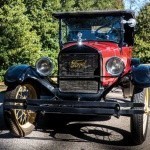This remarkably preserved example of the iconic Ford Model T Touring automobile, presented to us by master technician Robert Massengale, could be purchased in 1927 for less than $300.
Meanwhile, the Cadillac dealer down the street was selling his top models that year, to the few who could afford them, for about $4,000. We featured one of those in our classic car story last month.
There are few other examples of anything that transformed an entire society more than this juxtaposition of personal transportation vehicles a hundred years ago.
And, it all occurred by deliberate design from a daring risk taker who would become one of the world’s wealthiest people with a fortune estimated, in today’s dollars, of $200 billion.
Here’s how Henry Ford described his ambitious plans:
“I will build a motor car for the great multitude. It will be large enough for the family, but small enough for the individual to run and care for. It will be constructed of the best materials, by the best men to be hired, after the simplest designs that modern engineering can devise. But it will be so low in price that no man making a good salary will be unable to own one – and enjoy with his family the blessing of hours of pleasure in God’s great open spaces.” – Wikipedia
The first production Model T left the factory in 1908. It was a runaway success as, in a matter of days after the release, 15,000 orders had been placed. The last one emerged in 1927 from the first-ever moving assembly line that had been devised by Ford to achieve a level of production never imagined.
Between those dates more than 16 million of the car affectionately known as the “Tin Lizzie” had been sold.
1 EyeWitness to History explains the outcome: “At the beginning of the 20th century the automobile was a plaything for the rich. Henry Ford was determined to build a simple, reliable and affordable car; a car the average American worker could afford. Out of this determination came the Model T and the assembly line – two innovations that revolutionized American society and molded the world we live in today.”
Interestingly, the Model T was not Ford’s first attempt to achieve his promise. Together with colleagues we would say were innovative engineers and mechanics, after his first experiment in 1896, he developed the Model A in 1903.
The Model T got its name because Henry went all the way through the alphabet developing his final result. By the time he got to the Model N in 1906 he was then only two years away from the version he put into production.
Still, to meet the demand while reducing the cost to build them, the revolutionary method of moving the cars under construction along an assembly line instead of the workers moving from one station to the next had to be invented.
By the time that result had been fully achieved in 1913, the process began at the top floor of the four-story building where the engine was assembled and progressed level by level to the ground where the body was attached to the chassis.
That plant once employed 50,000 auto workers earning a wage of $5 per day (better than most jobs at the time), who worked in eight-hour shifts building the most popular vehicle of the era – Ford had captured close to half of the entire automobile industry.
Per the EyeWitness to History account, “A towrope was hitched to a chassis, this time pulled by a capstan. Each part was attached to the moving chassis in order, from axles at the beginning to bodies at the end of the line.”
As you take a look at Robert standing with this car that he maintains in its original, fully operational condition for its Fort Worth owner, you may be asking about its color.
You may have heard that Henry Ford famously said (no one seems to know for sure if he did) that you could buy his Model T in any color you wanted as long as it was black.
Actually, in its first five and last two years of production it was available in bright red (like this one), green, blue, brown, maroon and gray. The benefit to production was the black ones dried the fastest, so for 12 of the 19 years of production of this model, they were all black.
Finally, if you are wondering about the performance, the Model T’s four-cylinder engine produced 20 horsepower and reached speeds of 40-45 MPH – plenty for the roads of the day.
1 Henry Ford Changes the World, 1908, EyeWitness to History.com






















